HISTORY OF HAINAULT FOREST
HAINAULT'S FIRST FARMER
The House of Commons passed a Bill in 1819 for the disafforestation of Hainault Forest which got thrown out by the House of Lords. When the Government approached this issue again, it knew felling of Hainault trees would be unpopular, so instead of dragging feet as normally done in such Parliamentary matters, they pushed the 1851 Act of Disafforestation through with utmost, some would say 'obscene' haste, totally ignoring the public outcry. Many considered the destruction of Hainault Forest to be state sponsored vandalism. Others backed the scheme, eager to clear land for farming. John Alison, a keen supporter of the Bill, rubbed hands together in delight when the trees started falling because he envisaged great profit in the venture.
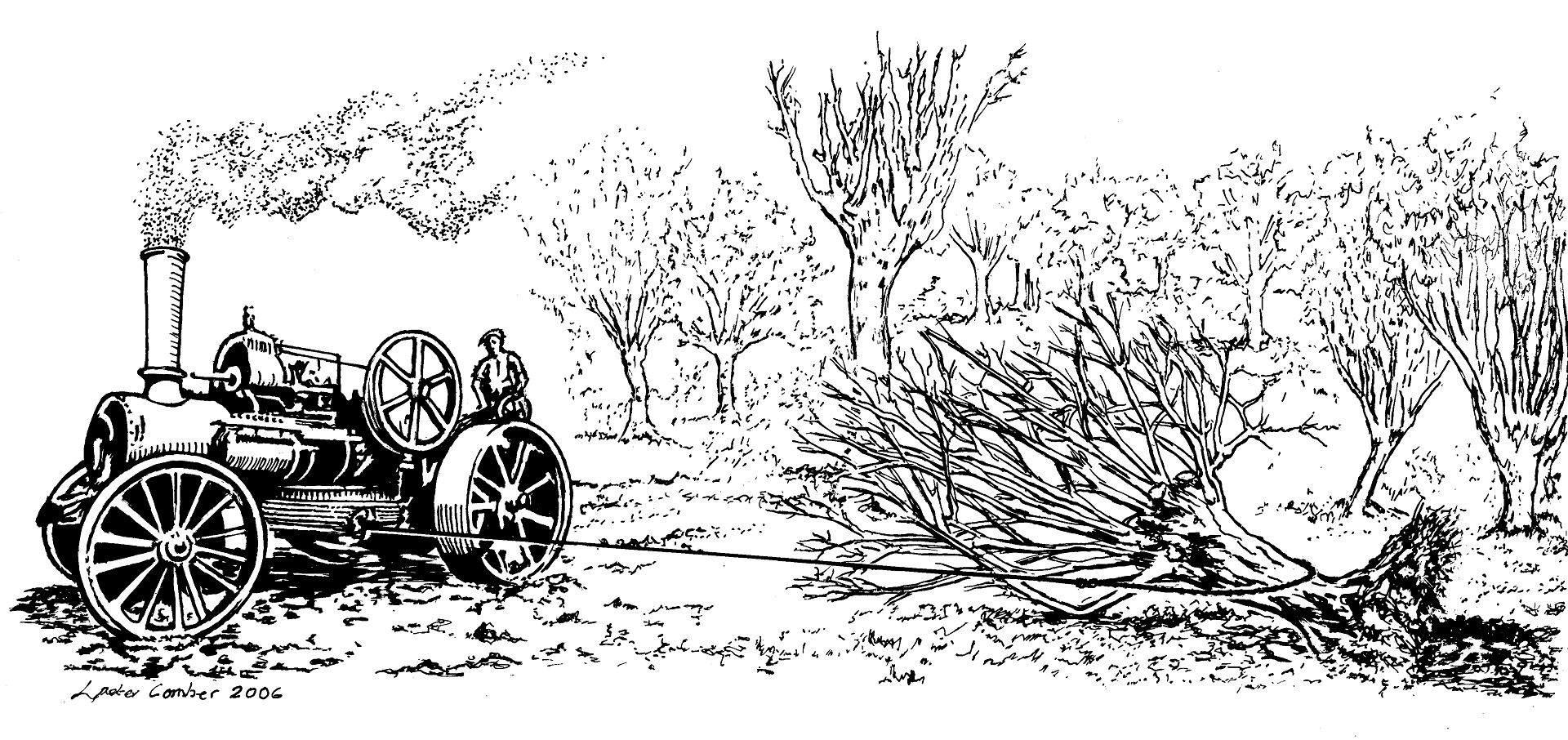
A steam plough engine being used to grub out a Hornbeam pollard. Illustration by L. Peter Comber.
New farms were to be built on Crown property and rented out by the Woods and Forests Department. In May 1853, 24,714 Oak trees, 3,377 Oak pollards, and 86,679 Hornbeam pollards stood on the allotment to be cleared. In addition many parts of the forest were covered in thick undergrowth. The soil was waterlogged to such a degree as to require a proper system of drainage before it could be profitably occupied for farming purposes. Four miles of public highway had to be created and the Crown was required to enclose the allotment and fence it from the roads.

Hainault Farm entrance 2016 © Raymond Small
The Allotment was placed under control of Commissioner Charles Gore. The only work required by the Act of Parliament that had been started when he took over was the preparation of timber for fences. Tenders were immediately obtained for building of roads and main drains. Work on these began in August 1853 and completion followed in October 1854.
Clearing of timber and undergrowth on the Crown Allotment proceeded. Lots of the timber got taken away to build ships for the British Navy. Attempts were made to let the land for grazing purposes. Advertisements were placed announcing that a portion of the Allotment would be made available for the erection of villa residences. No builders were interested. A deficiency of drinking water and lack of a railway station in the area may have been the reason for this. Contracts were made for manufacturing and laying drainage pipes at specified prices, Work on the drains commenced in April 1855. Tradesmen also agreed to buy stack-wood and other produce which would otherwise be unsaleable.
An offer was made by Messrs. John and Alexander Alison, to lease 1,235 acres for a term of 31 years, from 10th October 1854, at the following rents:
For the first year of the term - - £309.
For the second year of the term - £618.
For the residue of the term - £1,421 8s.
This was upon the understanding that they pay interest on all sums expended by the Crown for drainage, and for the construction of farm buildings, at the rate of 5 and 6 per cent, respectively. A large Farmhouse, Foreman's Residence, Cottages for four Labourers; Stabling for 28 horses; Wheelwright's Shop; a Cart and Cattle-Shed, with large Granary overhead; large Barns, and an Engine and Boiler House were built.
In the first year of tenancy, the Alison's had cultivated 250 acres. In addition to which, 700 acres were cleared by the Crown and partly ploughed by the Lessees. The rest of the land got cleared in the second year. An area of 1,165 had now been cultivated, of which upwards of 600 acres had been cropped with potatoes.

Forest Farm 2016 © Raymond Small
The following year, another deal got struck for a further 554 acres. This was the land considered available for building purposes for which no offers had previously been received, and also two small pieces of land in the vicinity containing another 50 acres. This lease got fixed to expire at the same time as the former letting and the rents for this second lease were:
For the first year of the term - - - £252 5s.
For the second year of the term - - £390 15s.
For the residue of the term - - - £1,196 5s.
Interest at the rate of 5 per cent on sums expended for under-drainage also had to be paid. In return, the Crown undertook to erect, at its own cost, a homestead, overseer's house, four cottages for labourers, and also provide an accommodation road, one and a half miles in length. The site also included stables for 28 horses; and a large Barn and Cart-shed with a large Granary over it.
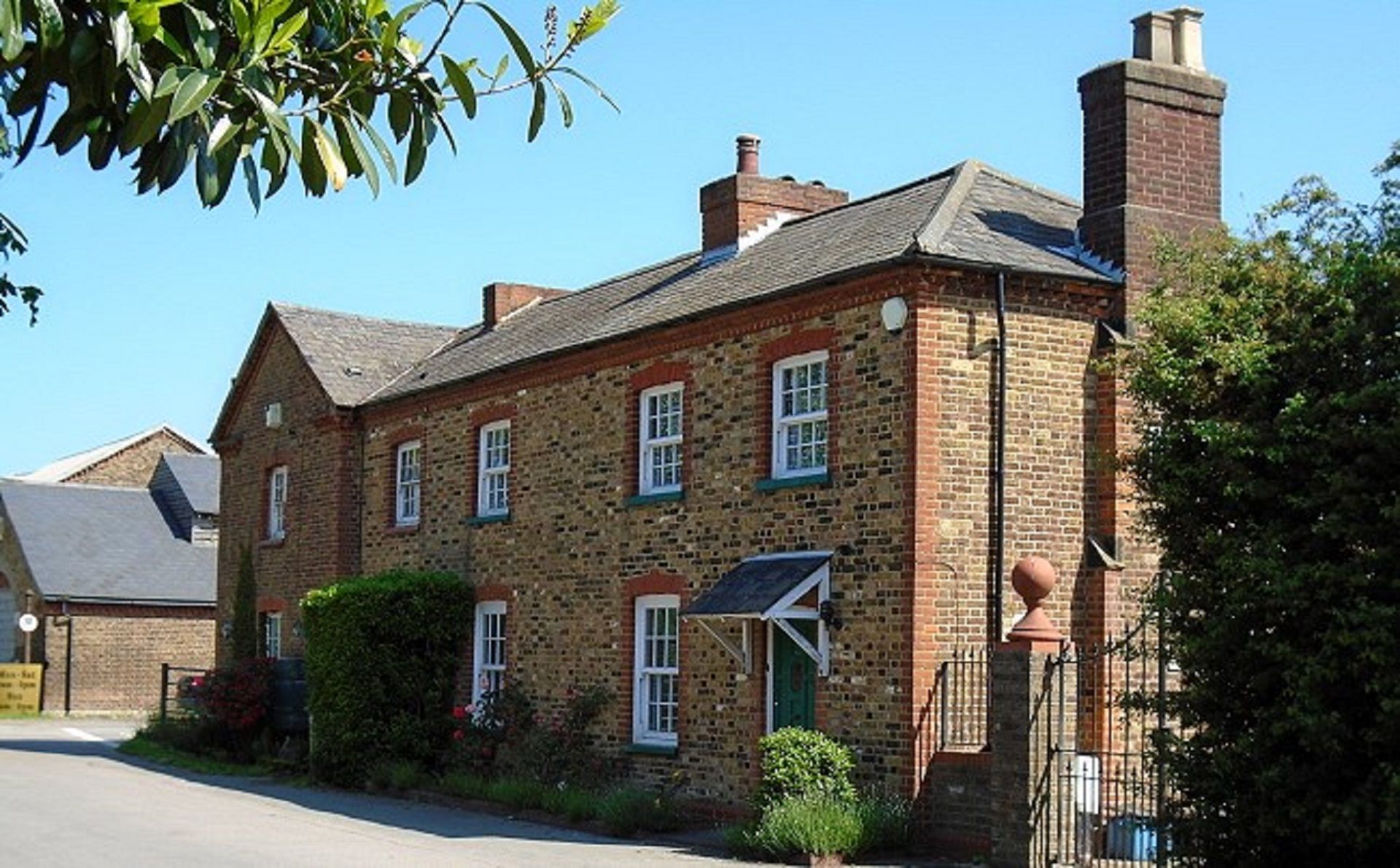
Forest Farm 2016 © Raymond Small
Further lettings of small amounts of land within the Forest boundaries were also made, which meant the whole Allotment, except for a few detached strips of land, was now under cultivation. More building took place, which included; a Bailiff's House, Cottages for four Labourers, Stables for 28 horses, a Cart-shed, and other conveniences. No interest was payable on this set of buildings.
Wheat now covered 850 acres, potatoes grew in 580 acres, 160 acres were under oats, and other crops filled the rest of the land. The land reclamation, which only a few years earlier had been 1,850 acres of open Forest, had been expensive to do. However, sales of timber made more than enough to cover the cost of clearing and draining all the land, as well as constructing the buildings.
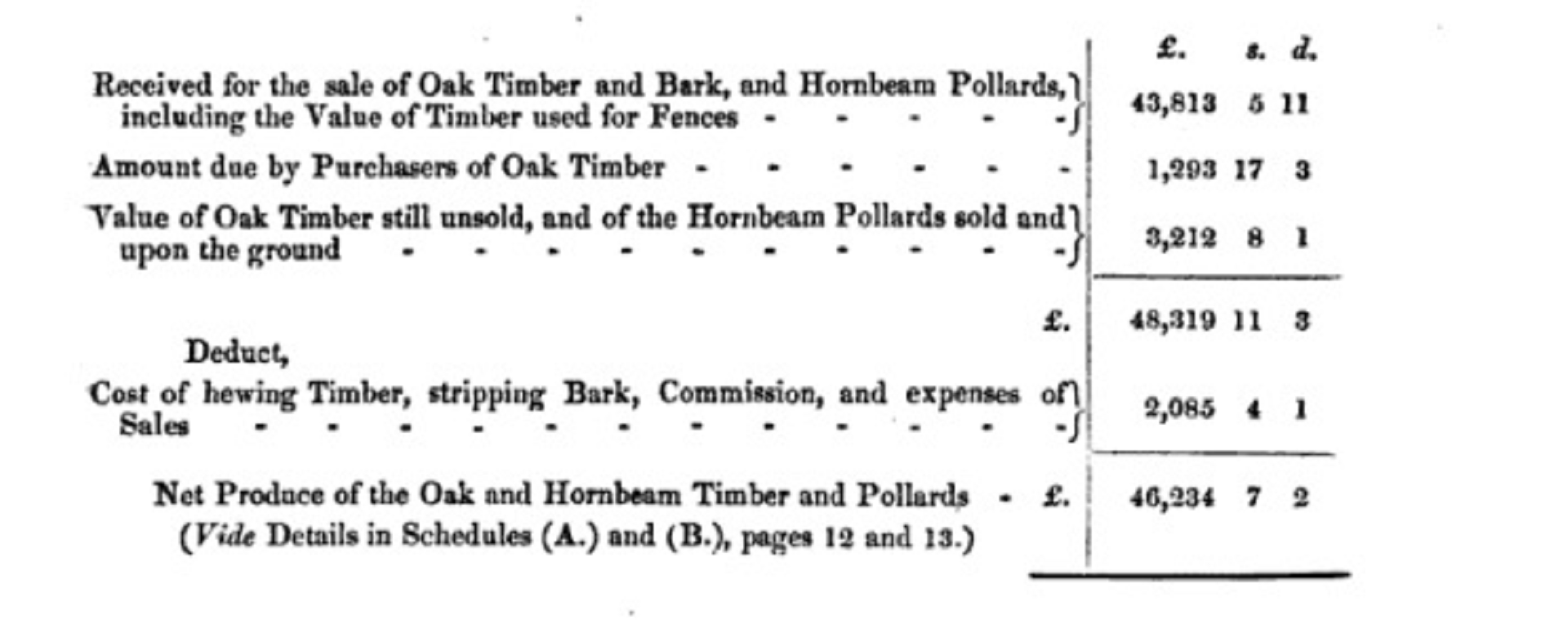
Accounts for sales of timber
The three new farms were called, Hainault, Forest and Fox Borrows. Each had its own manager that lived in a cottage on his own respective farm. Hainault Farm's soil varied from stiff clay to loam and gravel. It was managed by Mr. Neilson, who said: 'Deep cultivation has enabled us in part to dispense with open water-furrows. We only use them occasionally now on heavy land so as to relieve the surface as quickly as possible during very heavy rainfalls. In no case could drains be dispensed with.' He observed: 'Not any perceptible difference to be noted in commencing harvest, but crops after deep cultivation certainly ripen more evenly.'
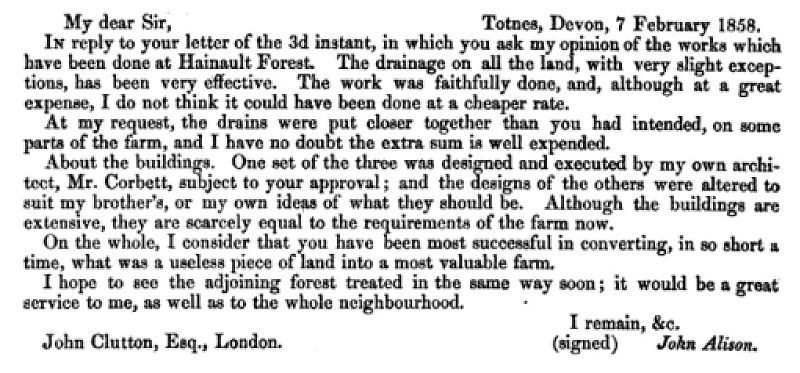
Several factors made the actual cost of drainage higher than originally estimated; pipes being placed closer together; men working day and night to get the job done quicker; dearer labour due to being near London; and excavating drains in soil intersected with roots.

Alison experimented with new farming techniques. To determine which fertilizer grew the best crops, part of a field on Hainault Farm got limed and another part received three hundredweight of guano. Mr. Alison used engines to plough land in spite of problems caused by land-fast roots. With the passing of time the roots of the old forest rotted away and disappeared.

Hainault Farm became a thriving business and issued trading tokens. Parliament's failure to provide sufficient small denomination coinage drove desperate traders to issue their own, particularly in low values that the average person used in daily life. Tokens were normally inscribed with the issuer's name, trade, and town of residence. Most were round, but square, oval, heart, diamond and octagonal shapes were also made. Tokens were usually restricted for use with the business that issued them so their decline was hardly surprising. Lead and pewter tokens existed, but those of copper and brass were more popular and gave rise to the expression, 'It's not worth a brass farthing'
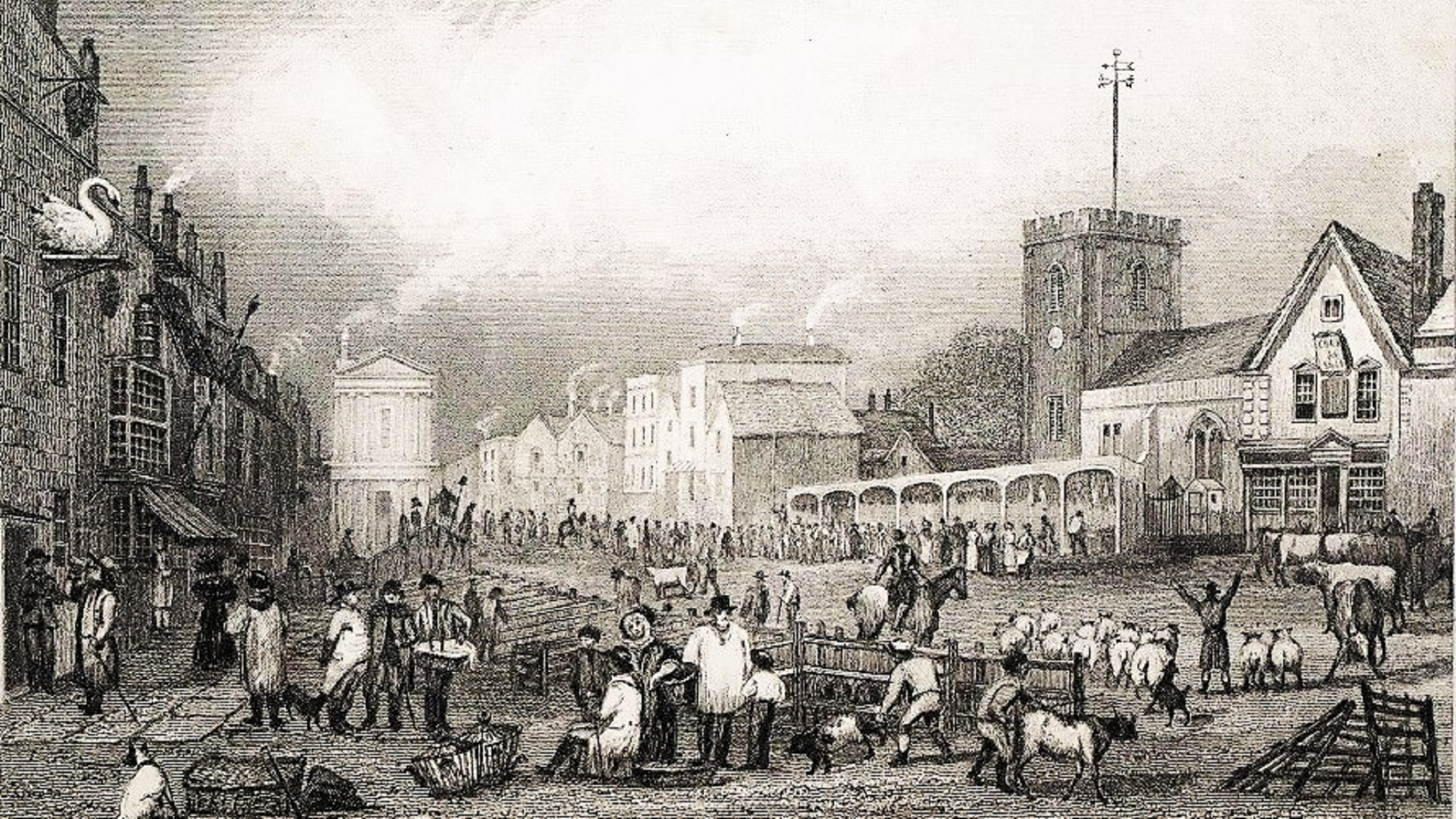
Romford Market was regularly visited by local farmers to buy and sell stock. Drawing by H. Wallis 1833.
In 1878, carts belonging to Hainault Farm stopped outside the Laurie Arms in Romford for refreshments. Thomas Keene distracted the drivers by reading from a newspaper. Meanwhile, Henry and William Packer removed coal from the back of the vehicles and threw it into a nearby garden. The three labourers may have got away with what the Chelmsford Chronicle described as a 'DARING ROBBERY', but Edmund Martin witnessed what was happening and promptly reported their crime to the police. Constable Wood apprehended the prisoners, The three protested their innocence, but when the coal they had hidden got discovered, they were remanded and brought up on charges.
The Patent Office acknowledged several of John Alison's inventions:
7th July, 1837 | John Alison, of Hainault Forest, in the county of Essex, Gentleman.
Improvements in preparing vegetable substances for feeding animals, and in apparatus for that purpose.
21st April 1859 | 1003. John Alison, of Hainault Forest, Essex, Gentleman, for an invention for-"An improved instrument for extirpating thistles, docks and other deep-rooted weeds." Letters Patent sealed.
25th February 1867 No. 516. Alison, John.-"Improvements in steam boilers." This Provisional Specification describes a boiler of an upright and cylindrical form ; the fire-box is an inner concentric cylinder contracted at the top into a flue which passes up and out through the top of the boiler, and the smokebox may contain a superheater. There are water tubes within the fire box ; they pass downwards from the crown thereof and are bent round so as to pass out through the vertical cylinder which forms its sides. The upper part of the boiler is connected with the lower part and with the fire box, and its flue with flanges and bolts and nuts, so that the parts may be readily separated.
Alison attempted to take advantage of the Agricultural Holdings Act and claimed £2,605 13s. 6d. for buildings and improvements, and for the inexhaustible value of manure put on the land. The Crown counter-claimed for £4,678 0s. 8d., citing dilapidation, foul land, and breeches of contract, stating that the farms were in a poor state due to bad farming methods. Gas lime, a by-product in the purification of town gas, had been used instead of manure, and improvements to buildings had been made without planning permission. Adjudicator, Mr. E.P. Squarey, weighed up evidence. With large sums involved other farmers paid close attention to the proceedings. Thomas Champness, representing Mr. Alison, and Mr. J.W. Komaly, for the Crown, waited for the ruling. The verdict favoured the Crown. Alison had to pay £3,475 12s. 8d. in damages, it being discovered that the gas-lime had little value as manure. No doubt, John Alison, cursed the day he heard of Agricultural Holdings Act and it probably made other farmers think twice before putting in their own claims.
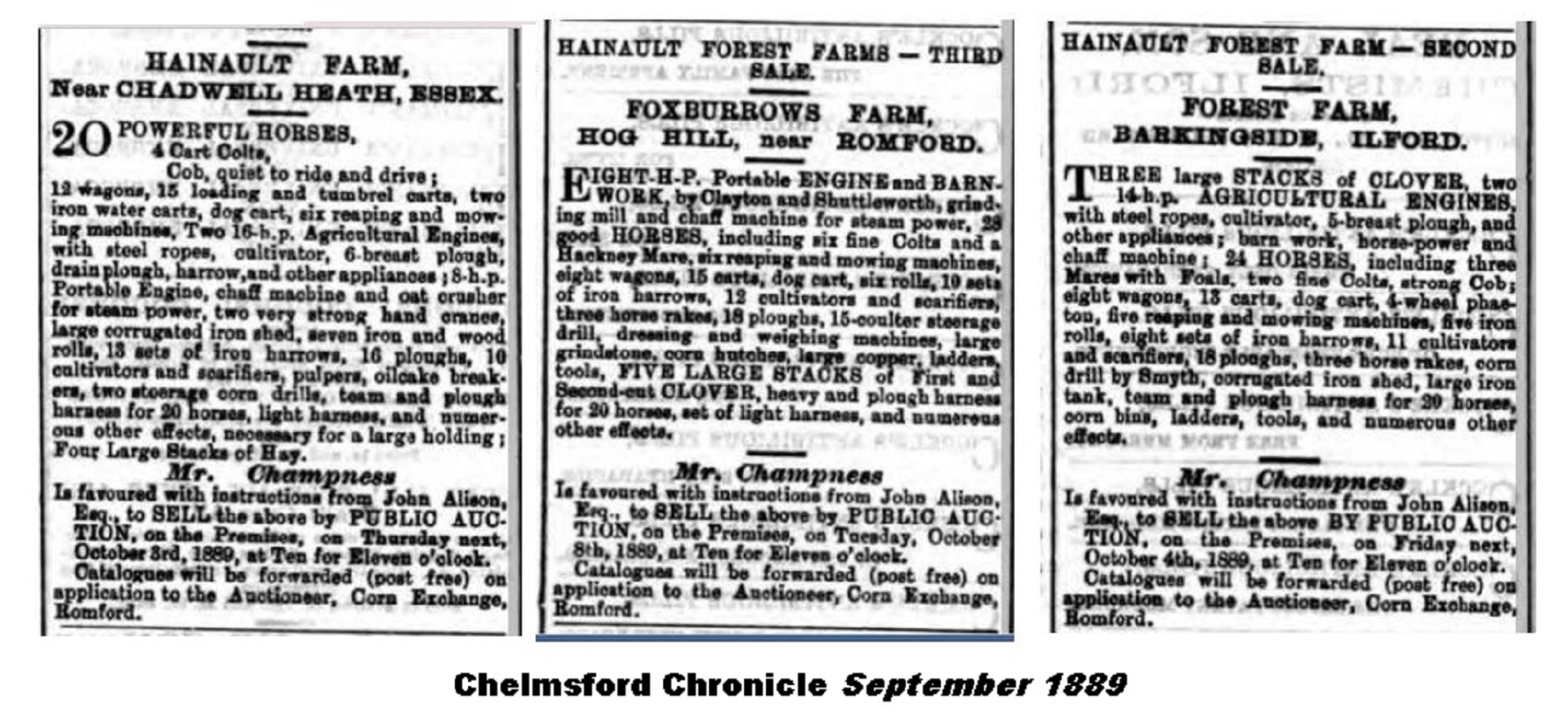
Auctions were held when John Alison decided to leave the farms and sell the equipment.
By Raymond Small and Elaine Wiltshire. Thanks to Peter Comber for his illustration.

